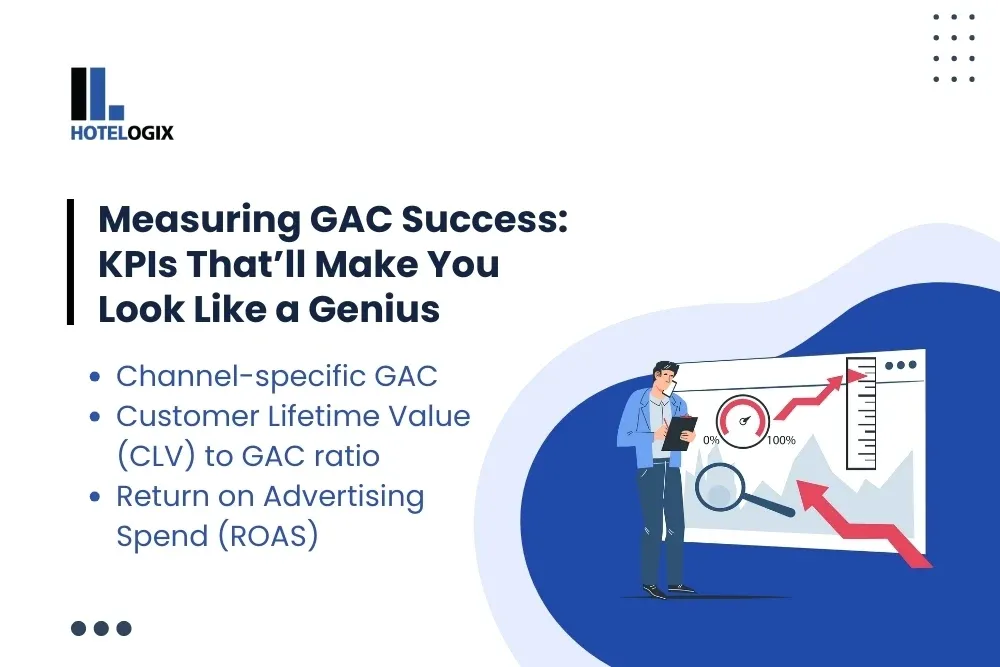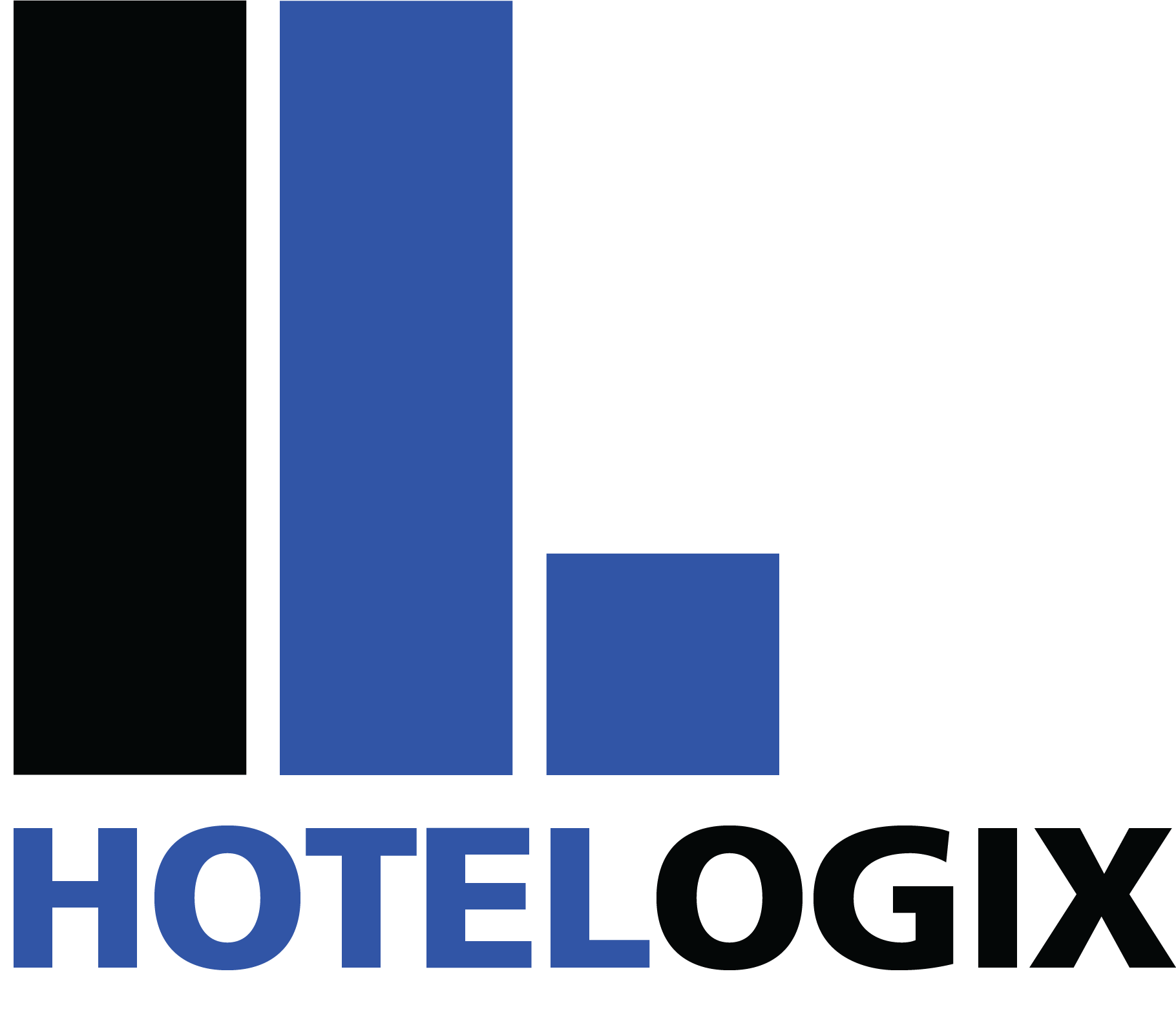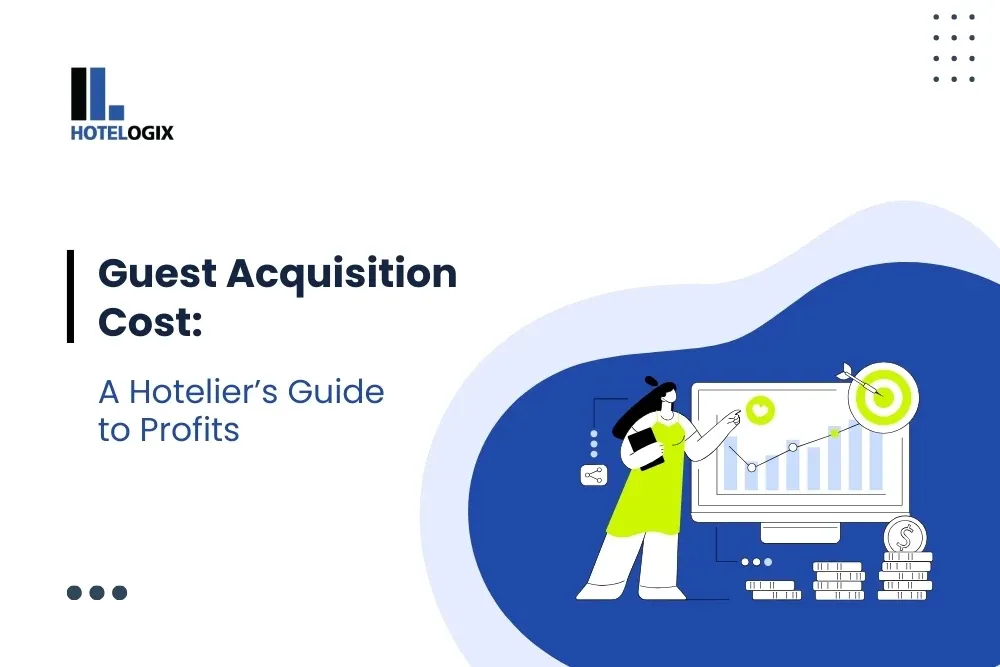Hey there, savvy hoteliers! Ready to crack the code on Guest Acquisition Cost (GAC) and turn your property into a profit-generating machine? Buckle up, because we’re about to embark on a wild ride through the ever-changing landscape of hotel marketing in 2025.
Let’s face it: the hospitality industry is as cutthroat as a Gordon Ramsay kitchen on a bad day. With OTAs gobbling up commissions like they’re at an all-you-can-eat buffet and guests expecting the moon on a silver platter, keeping your GAC in check is tougher than getting a five-star review from a hangry traveler. But fear not! We’re here to help you navigate these choppy waters and come out on top.
In this guide, we’ll dive deep into the world of GAC, serving up a heaping helping of insider tips, jaw-dropping stats, and game-changing strategies that’ll have you slashing costs and boosting bookings faster than you can say “complimentary breakfast.” So, are you ready to turn your hotel into the talk of the town (and the envy of your competitors)? Let’s dive in!
What the Heck is GAC, Anyway?
Alright, let’s start with the basics. Guest Acquisition Cost (GAC) is the amount of cold, hard cash you shell out to get a shiny new guest through your doors. It’s like the price tag on your marketing efforts, covering everything from those flashy Instagram ads to the commission you begrudgingly pay to OTAs.
The GAC Formula: Math That Actually Matters
Here’s the magic formula that’ll have you crunching numbers like a pro:
Simple, right? But don’t let its simplicity fool you – this little equation packs a punch when it comes to understanding your hotel’s financial health.
Why GAC Should Be Your New BFF
Listen up, because this is important: GAC is the secret sauce to maximizing your profits. Here’s why you should care:
- It’s a reality check: GAC shows you exactly how much you’re spending to fill those rooms. No more guesswork or crossing your fingers!
- It’s a performance indicator: A low GAC means you’re a marketing maestro. A high GAC? Well, let’s just say there’s room for improvement.
- It guides your strategy: Knowing your GAC helps you decide where to invest your marketing moolah for the biggest bang for your buck.
The 2025 GAC Landscape: Trends That’ll Knock Your Socks Off
Buckle up, buttercup, because the GAC game is changing faster than a guest’s mind about the minibar prices. Here are the trends shaping the 2025 landscape:
AI: Your New Revenue Wingman
Artificial Intelligence isn’t just for sci-fi movies anymore. In 2025, AI is the hotshot revenue manager you’ve always dreamed of:
- Hyper-accurate predictions: AI-powered tools like Mews and Atomize are crunching data faster than you can say “occupancy rate,” giving you real-time GAC insights that’ll make your head spin.
- Dynamic pricing on steroids: Forget basic supply and demand. AI is considering factors like guest lifetime value, local events, and even the weather to optimize your rates and keep that GAC low.
- Personalization paradise: AI is helping you tailor your marketing messages to each guest’s preferences, boosting conversion rates and lowering acquisition costs.
The OTA Tug-of-War: Finding Balance in the Booking Battlefield
OTAs are like that frenemy who always shows up uninvited to your party – annoying, but sometimes useful. Here’s the 2025 OTA landscape:
- Commission creep: OTA commissions that once ranged from 15-20% now reach 30% or higher. Some hotels are even paying up to 40% when you factor in those sneaky volume discounts.
- The direct booking revolution: By 2030, direct digital bookings are expected to dominate hotel distribution, generating over $400 billion in gross bookings – finally outpacing those pesky OTAs!
- Metasearch madness: Google Hotel Finder is expanding faster than a guest’s waistline at the breakfast buffet. Other metasearch channels are scrambling to keep up, which means more opportunities (and challenges) for savvy hoteliers.
Sustainability: The Green Machine That Drives Bookings
Going green isn’t just good for the planet – it’s good for your bottom line, too:
- Eco-conscious guests: More travelers are choosing hotels based on their sustainability practices. Showcasing your green initiatives can lower your GAC by attracting these environmentally-minded guests.
- Energy-efficient savings: Implementing sustainable practices not only attracts guests but also lowers your operational costs, indirectly improving your GAC.
- Green certifications: Earning eco-friendly certifications can boost your visibility and appeal, potentially lowering your marketing costs in the long run.
Slashing Your GAC: Strategies That Actually Work
Enough with the trends – let’s get down to brass tacks. Here are some tried-and-true strategies to keep your GAC lower than a limbo champion:
Direct Bookings: The Holy Grail of Low GAC
Direct bookings are like finding a $20 bill in your pocket – unexpected and oh-so-sweet. Here’s how to get more of them:
- Website wizardry: Optimize your website for conversions faster than a guest can say “book now.” Think lightning-fast load times, mobile-friendly design, and a booking process smoother than a fresh set of sheets.
- Content is king: Create irresistible content that’ll have potential guests drooling over their keyboards. Blog posts, virtual tours, and behind-the-scenes peeks can all drive traffic to your site and boost direct bookings.
- Email marketing magic: Don’t underestimate the power of a well-crafted email campaign. Personalized offers and exclusive deals can entice past guests to book directly, lowering your GAC in the process.
Loyalty Programs: Turning One-Night Stands into Long-Term Relationships
Who doesn’t love feeling special? A killer loyalty program can transform casual guests into die-hard fans:
- Personalization is key: Use data to tailor rewards to each guest’s preferences. Maybe Susan loves spa treatments, while Bob can’t resist a good golf package.
- Make it easy: Ensure your loyalty program is as easy to use as ordering room service at 2 AM. The simpler it is, the more likely guests are to participate.
- Partner up: Team up with local attractions or airlines to offer unique rewards that’ll have guests choosing your hotel over the competition.
Tech Stack Optimization: Work Smarter, Not Harder
In 2025, your tech stack should be working harder than a bellhop during peak season:
- All-in-one solutions: Look for platforms that integrate multiple functions, from property management to revenue management. Fewer systems mean lower costs and better data flow.
- Automation nation: Embrace automation like a long-lost friend. From chatbots handling guest inquiries to automated email marketing campaigns, let technology take some of the load off your plate.
- Data-driven decisions: Use analytics tools to track your GAC across different channels and campaigns. If something’s not working, don’t be afraid to pull the plug faster than you would on a noisy guest at 3 AM.
Measuring GAC Success: KPIs That’ll Make You Look Like a Genius

You can’t improve what you don’t measure. Here are some key performance indicators (KPIs) to keep an eye on:
- Channel-specific GAC: Calculate your GAC for each booking channel to identify which ones are giving you the most bang for your buck.
- Customer Lifetime Value (CLV) to GAC ratio: This fancy-sounding metric helps you determine if you’re spending the right amount to acquire high-value guests.
- Return on Advertising Spend (ROAS): Make sure your marketing dollars are working as hard as you are by tracking the revenue generated from each campaign.
How Hotelogix’s Web Booking Engine Lowers GAC
One of the most effective ways to slash your Guest Acquisition Cost is to increase direct bookings—that’s where Hotelogix’s Web Booking Engine comes in.
Why it Matters: Direct bookings mean zero OTA commissions, higher profit margins, and stronger guest relationships. Instead of handing over 15-30% of your revenue to third-party platforms, you keep more of what you earn.
- Seamless User Experience: A sleek, mobile-friendly interface that makes booking a breeze for guests.
- Multiple Payment Gateways: Secure, hassle-free transactions with global payment options.
- Real-Time Rate and Inventory Management: This ensures that your best rates are always displayed to potential guests, maximizing conversions.
- Integration with Metasearch and Google Hotels: Boosts visibility where travelers actively search, driving high-quality direct traffic.
- Add-ons and Upsells: Increase your revenue per guest by offering special deals, packages, and room upgrades directly through the booking process.
By leveraging a powerful booking engine like Hotelogix, you can drive more direct bookings, lower your dependency on OTAs, and significantly reduce your GAC. The result? A stronger bottom line and better control over guest relationships.
The Future of GAC: Crystal Ball Predictions for 2026 and Beyond
Put on your futurist hat, because we’re about to gaze into the crystal ball of hotel marketing:
- Voice search optimization: As more travelers use voice assistants to book travel, optimizing for voice search will become crucial for lowering GAC.
- Virtual reality experiences: Imagine letting potential guests “try before they buy” with VR tours of your property. It could revolutionize the booking process and lower acquisition costs.
- Blockchain for transparent pricing: Some innovative hotels are already using blockchain to provide unprecedented transparency in their GAC calculations, building trust with both guests and investors.
Conclusion: Your GAC Action Plan for World Domination
Alright, hotshot, you’re now armed with enough GAC knowledge to make even the most seasoned revenue manager jealous. Here’s your action plan for GAC greatness:
- Calculate your current GAC across all channels. Knowledge is power, people!
- Identify your lowest and highest GAC channels. It’s time to double down on the winners and cut the losers loose.
- Invest in AI-powered tools to supercharge your pricing and personalization efforts.
- Revamp your direct booking strategy like your profit margins depend on it (because they do).
- Launch a loyalty program that’ll have guests more devoted than a Taylor Swift fan at a concert.
- Optimize your tech stack to work smarter, not harder.
- Track those KPIs like a hawk and adjust your strategy accordingly.
Remember, in the wild world of hotel marketing, the only constant is change. Stay curious, stay adaptable, and never stop looking for ways to lower that GAC. Your bottom line (and your stress levels) will thank you.
Now go forth and conquer, you GAC-slashing superstar! The world of profitable bookings awaits!
Got questions about implementing these GAC-busting strategies? Want to share your own GAC success story? Drop a comment below, and let’s keep the conversation going. Here’s to your success in 2025 and beyond!


